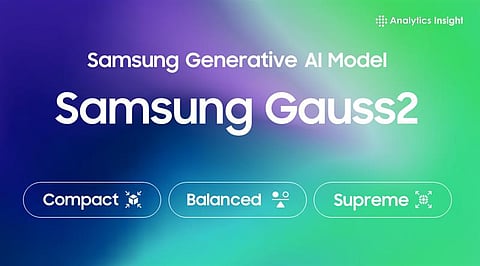

Samsung is rapidly expanding its artificial intelligence capabilities with the launch of its Agentic AI Builder and upgraded Gauss models. These innovations are a major milestone in the company's plan to strengthen its AI ecosystem and reduce its reliance on external suppliers.
Imagine creating personalised AI agents with a simple drag-and-drop interface that effortlessly handles text, code, and images. The new Gauss 2.3 series, together with the Agentic Builder platform, is enabling unparalleled power and efficiency in AI development. This breakthrough suggests a scenario in which AI will be an inevitable, smart assistant in every Samsung device.
Samsung has unveiled its own Agentic AI development environment. According to SamMobile’s reports, the new “Agentic Builder” is built on the latest versions of the company’s proprietary generative AI platform. The tool allows developers to assemble custom AI agents using building-block components like input/output windows, AI models, and logic structures, all via a drag-and-drop interface.
This step reflects Samsung Research’s strategic drive to reduce reliance on external AI providers. With Agentic Builder, teams can rapidly prototype business-critical agents without deep coding or LLM engineering expertise.
The core of this push is an upgraded family of AI models. Samsung’s generative-AI system now includes models named Gauss 2.3, Gauss 2.3 Think, and Gauss O Flash. The new models go further than Samsung Gauss2, which was also the successor to the first one introduced in 2023.
The Gauss 2 multimodal model was unveiled at the 2024 Developer Conference and could process not only the language but also code and images. It was available in three different versions: Compact for use on devices, Balanced for doing various tasks, and Supreme for high-performance cloud-based workloads.
According to Samsung, these models can support up to 14 languages, in addition to various programming languages. They also provide faster processing and better efficiency than many open-source alternatives. The newly announced Gauss 2.3 series builds on this foundation to power Agentic Builder and internal tools, promising even better performance and flexibility.
One major beneficiary is an internal knowledge-search system code-named Sirius. This tool uses Gauss’ multimodal capabilities to allow users to search across documents, technical data, tables, images, and attachments, overcoming limitations of traditional keyword-based search.
According to reports, Sirius is currently being tested as a beta service for Samsung employees working on product development and technical tasks. Another internal upgrade involves improved image-generation models built on the enhanced Gauss infrastructure.
Samsung claims the new image generation models can more faithfully transform objects based on natural language prompts, even when creating visuals of novel or previously unseen objects. Reportedly, internal use of these models has surged by over 150 per cent since the release of the new version.
Samsung is preparing for a broader rollout of AI in consumer devices. The company reportedly aims to integrate its Agentic AI tools and Gauss-powered models in upcoming hardware. Industry rumours suggest that future flagship devices, such as the Samsung Galaxy S26, could be among the first smartphones to support full “agentic AI” features across the system.
This method allows users to select various AI agents, such as Gauss Cloud, Google Gemini, or Perplexity, depending on their needs. Such flexibility across different agents could greatly expand the range of tasks smartphones can offer users, ranging from language assistance through content creation to data management.
Also Read: Samsung Galaxy S25 Ultra: A Leap into the Future of AI-Powered Smartphones
Samsung’s latest AI developments demonstrate clear improvements in both performance and versatility. The Gauss 2.3 series, with the Agentic Builder, delivers more effective, multimodal capabilities that empower internal teams and also enable smooth AI integration in different workflows.
These tools are now being integrated into consumer devices, enabling a faster, more intelligent response to users' needs. By providing multi-agent support and incorporating sophisticated AI capabilities, Samsung is signalling its intention to allow users to access next-generation AI technology, thereby changing people’s perceptions of how everyday devices assist and interact.
